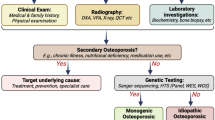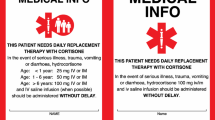Abstract
Summary
The congenital adrenal hyperplasia population seems to have an intrinsic tendency to a high frequency of low bone mass. However in this single-center and long-term evaluated cohort, the simplified corticoid regimen, with exclusive dexamethasone single dose reposition during adulthood, did not represent a risk factor for decrease in bone health.
Introduction
The impact of long-term and supposedly physiological doses of gluco and mineralocorticoid (GC/MC) on bone mineral density (BMD) in congenital adrenal hyperplasia (CAH) remains discordant among studies, which contain different clinical forms and corticoid regimens. Our aim was to evaluate the BMD in CAH adults receiving similar GC regimen since childhood and to correlate it with GC/MC cumulative doses.
Methods
Only patients with good compliance, who used cortisone acetate (CA) during childhood and dexamethasone after the final height achievement. Cumulative GC/MC doses were calculated from diagnosis until last evaluation. BMD was analyzed by the first and last energy X-ray absorptiometry (DXA) scans performed.
Results
Twenty simple virilizing (SV) and 14 salt wasting (WS) whose mean age was 26 ± 6 years, mean CA, dexamethasone, and fludrocortisone cumulative doses were 63,813 ± 32,767, 812 ± 558, and 319 ± 325 mg/m2, respectively. Based on the last DXA, low BMD was observed in 11% of patients, total hip Z-score was lower in the SW than SV form (p = 0.04). Cumulative CA dose had an inverse correlation with femoral neck Z-score (p < 0.01). Total cumulative GC and MC doses had an inverse correlation with total hip Z-score (p < 0.01). In the analysis of sequential BMD during dexamethasone therapy, no association was observed among cumulative GC/MC doses, clinical forms, sex, and lumbar Z-score delta.
Conclusions
Even though a low CA regimen during growth periods in addition to MC replacement appears to have an influence on BMD at femoral sites, interestingly a low dexamethasone one does not seem to be deleterious for bone health in adulthood.



Similar content being viewed by others
References
Hayashi G, Faure C, Brondi MF, Vallejos C, Soares D, Oliveira É, Brito VN, Mendonca BB, Bachega TASS (2011) Weight-adjusted neonatal 17OH-progesterone cutoff levels improve the efficiency of newborn screening for congenital adrenal hyperplasia. Arq Bras Endocrinol Metabol 55:632–637
White PC (2009) Neonatal screening for congenital adrenal hyperplasia. Nat Rev Endocrinol 5(9):490–498
Falhammar H, Filipsson Nyström H, Wedell A, Thorén M (2011) Cardiovascular risk, metabolic profile, and body composition in adult males with congenital adrenal hyperplasia due to 21-hydroxylase deficiency. Eur J Endocrinol 164(2):285–293
Arlt W, Willis DS, Wild SH, Krone N, Doherty EJ, Hahner S, Han TS, Carroll PV, Conway GS, Rees DA, Stimson RH, Walker BR, Connell JM, Ross RJ, United Kingdom Congenital Adrenal Hyperplasia Adult Study Executive (CaHASE) (2010) Health status of adults with congenital adrenal hyperplasia: a cohort study of 203 patients. J Clin Endocrinol Metab 95(11):5110–5121
Falhammar H, Filipsson H, Holmdahl G, Janson PO, Nordenskjöld A, Hagenfeldt K, Thorén M (2007) Fractures and bone mineral density in adult women with 21-hydroxylase deficiency. J Clin Endocrinol Metab 92(12):4643–4649
Stikkelbroeck NMML et al (2003) Normal bone mineral density and lean body mass, but increased fat mass, in young adult patients with congenital adrenal hyperplasia. J Clin Endocrinol Metab 88(3):1036–1042
El-Maouche D et al (2015) Cortical bone mineral density in patients with congenital adrenal hyperplasia due to 21-hydroxylase deficiency. Clin Endocrinol 82(3):330–337
Bachelot A et al (2015) Determining clinical and biological indicators for health outcomes in adult patients with childhood onset of congenital adrenal hyperplasia. Eur J Endocrinol 173(2):175
de Carvalho DF, Miranda MC, Gomes LG, Madureira G, Marcondes JA, Billerbeck AE, Rodrigues AS, Presti PF, Kuperman H, Damiani D, Mendonca BB, Bachega TA (2016) Molecular CYP21A2 diagnosis in 480 Brazilian patients with congenital adrenal hyperplasia before newborn screening introduction. Eur J Endocrinol 175(2):107–116
Chakhtoura Z, Bachelot A, Samara-Boustani D, Ruiz JC, Donadille B, Dulon J, Christin-Maître S, Bouvattier C, Raux-Demay MC, Bouchard P, Carel JC, Leger J, Kuttenn F, Polak M, Touraine P, Centre des Maladies Endocriniennes Rares de la Croissance and Association Surrénales (2008) Impact of total cumulative glucocorticoid dose on bone mineral density in patients with 21-hydroxylase deficiency. Eur J Endocrinol 158(6):879–887
Jaaskelainen J, Voutilainen R (1996) Bone mineral density in relation to glucocorticoid substitution therapy in adult patients with 21-hydroxylase deficiency. Clin Endocrinol 45(6):707–713
WHO Guidelines Approved by the Guidelines Review Committee, in Global Recommendations on Physical Activity for Health. 2010, World Health Organization 2010: Geneva
Institute of Medicine Committee to Review Dietary Reference Intakes for Vitamin, D. and Calcium, The National Academies Collection: Reports funded by National Institutes of Health, in Dietary Reference Intakes for Calcium and Vitamin D, A.C. Ross, et al., Editors. 2011, National Academies Press (US) National Academy of Sciences.: Washington (DC)
Shuhart CR et al (2019) Executive Summary of the 2019 ISCD Position Development Conference on Monitoring Treatment, DXA Cross-calibration and Least Significant Change, Spinal Cord Injury, Periprosthetic and Orthopedic Bone Health, Transgender Medicine, and Pediatrics. J Clin Densitom
Boyce AM, Gafni RI (2011) Approach to the child with fractures. J Clin Endocrinol Metab 96(7):1943–1952
Ceccoli L, Ronconi V, Giovannini L, Marcheggiani M, Turchi F, Boscaro M, Giacchetti G (2013) Bone health and aldosterone excess. Osteoporos Int 24(11):2801–2807
Speiser PW et al (2018) Congenital adrenal hyperplasia due to steroid 21-hydroxylase deficiency: an Endocrine Society clinical practice guideline. J Clin Endocrinol Metab 103(11):4043–4088
Ajish TP, Praveen VP, Nisha B, Kumar H (2014) Comparison of different glucocorticoid regimens in the management of classical congenital adrenal hyperplasia due to 21-hydroxylase deficiency. Indian J Endocrinol Metab 18(6):815–820
Ceccato F et al (2016) Long-term glucocorticoid effect on bone mineral density in patients with congenital adrenal hyperplasia due to 21-hydroxylase deficiency. Eur J Endocrinol 175(2):101–106
Fumoto T, Ishii KA, Ito M, Berger S, Schütz G, Ikeda K (2014) Mineralocorticoid receptor function in bone metabolism and its role in glucocorticoid-induced osteopenia. Biochem Biophys Res Commun 447(3):407–412
Kamalov G, Bhattacharya SK, Weber KT (2010) Congestive heart failure: where homeostasis begets dyshomeostasis. J Cardiovasc Pharmacol 56(3):320–328
Pinheiro MM et al (2009) Nutrient intakes related to osteoporotic fractures in men and women--the Brazilian Osteoporosis Study (BRAZOS). Nutr J 8:6
Balk EM, Adam GP, Langberg VN, Earley A, Clark P, Ebeling PR, Mithal A, Rizzoli R, Zerbini CAF, Pierroz DD, Dawson-Hughes B, International Osteoporosis Foundation Calcium Steering Committee (2017) Global dietary calcium intake among adults: a systematic review [published correction appears in Osteoporos Int. 2018 Feb 26]. Osteoporos Int 28(12):3315–3324
Funding
Iervolino LL was supported by the FAPESP (grant number 2016/09674-2).
Author information
Authors and Affiliations
Corresponding author
Ethics declarations
Conflicts of interest
None.
Additional information
Publisher’s note
Springer Nature remains neutral with regard to jurisdictional claims in published maps and institutional affiliations.
Rights and permissions
About this article
Cite this article
Iervolino, L.L., Ferraz-de-Souza, B., Martin, R.M. et al. Real-world impact of glucocorticoid replacement therapy on bone mineral density: retrospective experience of a large single-center CAH cohort spanning 24 years. Osteoporos Int 31, 905–912 (2020). https://doi.org/10.1007/s00198-019-05268-0
Received:
Accepted:
Published:
Issue Date:
DOI: https://doi.org/10.1007/s00198-019-05268-0




